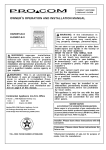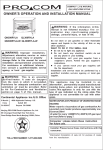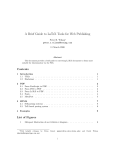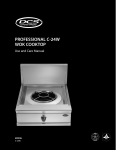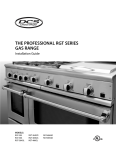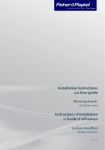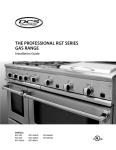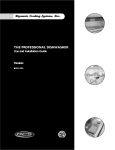Download DCS C-24W Installation manual
Transcript
CARE & INSTALLATION MANUAL PROFESSIONAL A DCS-C-24W WOK COOKTOP MODEL DESI GN R I CAN ME A A S ® N G S S O O TI CE C I A D R TIFIE Retain this manual for future reference. TABLE OF CONTENTS I N S TA L L AT I O N I N S T R U C T I O N S : USE AND CARE INSTRUCT I O N S : STEP 1: Safety Precautions ..............................2 Warning....................................................10 STEP 2: Cabinet Preparation Cooktop Installation .........................3-4 Section One: Precautions Safety....................................11-12 STEP 3: Placing & Anchoring...........................5 Section Two: Before using your appliance Operation...........................13 STEP 4: Electrical Connection & Grounding......................5-6 Section Three: Using the Wok General Use........................14 STEP 5: Gas Requirements LP Conversion.....................................7 STEP 6: Backguard Installation.........................8 Section Four: Care & Maintenance Cleaning............................15 STEP 7: Test and Adjustment.....................8 Adjustable Low Setting .....................8-9 Section Five: Warranty.................................16 STEP 8: Final Checklist....................................9 WARNING: If the information in this manual is not followed exactly, a fire or explosion may result, causing property damage, personal injury, or death. - Do not store or use gasoline or other flammable vapors and liquids in the vicinity other appliance. of this or any - WHAT TO DO IF YOU SMELL GAS • Do not try to light any appliance. • Do not touch any electrical switch; do not use any phone in your building. • Immediately call your gas supplier from a neighbor’s phone. Follow the gas supplier’s instructions. • If you cannot reach your gas supplier, call the fire department. - Installation and service must be performed by a qualified installer, service agency or the gas supplier. 1 SAFETYHEADER PRECAUTIONS STEP 1: PRECAUTIONS CAUTION WARNING: When connecting unit to LP gas make certain the LP gas tank is equipped with its own high pressure regulator in addition to the pressure regulator supplied with the cooktop. The maximum gas pressure to this appliance is not to exceed 14.0 inches water column from LP gas tank. Disconnect power before installing Before turning power on, be sure that all controls are in the “off ” position. Read entire instructions before proceeding installation must comply with all applicable codes. FOR YOUR SAFETY: * All top covers and chopping blocks must be removed before using the appliance. * No cooking utensil should be used on top of the grill. * Never block the front face of the unit as it will affect the flow of combustion and ventilation of air. Important Installation Information: Tested in accordance with ANSI Z21.1 - 1987 Standard for Household Cooking Gas Appliances. Check local building codes for the proper method of cooktop installation. In the absence of local codes the cooktop should be installed in accordance with the National Fuel Code #Z2231-1984 and National Electrical Code ANSI/NFPA No. 70-1987. 2 CABINET PREPARATION STEP 2: COOKTOP INSTALLATION FIG. 6 1. To ensure professional results, the cabinet and countertop openings should be prepared by a qualified cabinet worker. 2. The clearances shown in Fig.1 are required for installations of cooktop and islands. Counter-Sunk Screws 3. The cooktop is designed to hang from the countertop by its side flanges. The countertop how ever, must be strong enough to support this heavy cooktop. It may be necessary to add a 2 x 4 corner brace (See Figs.3, 4, and 5). Another alternate would be to construct a deck to set the cooktop on. 26-3/8" FIG. 2 12" Countertop level 9" 4. The cooktop can be installed in various positions with the front either flush or projecting, depending on the countertop depth. (See Fig.2 side view of cooktop; see Figs.3-5 for alternate mounting positions.) 1/2" 3" To Center Line of Gas Inlet 3/4" 22-5/8" 23-3/8" 2" Cabinet face for installation with projecting control panel Cabinet face for installation with flush control panel 777fig07 FIG. 1 VENT HOOD 12" Min. to Combustible Material , Each Side 30" Min., 36" Max. 18" Min. WALL 3" min each side 13" Min. 0" Rear Clearance (w/ backguard) 12" (w/out backguard) counter top level CAUTION: 36" Min. to combustible material , from cooking surface 0" Side Cutout Clearance 0" Bottom Clearance 777fig12 as defined in the "National Fuel Gas Code" (ANSI Z223.1, Latest Editon). > The level of the cooktop top must be at the same level or above the countertop level. 3 CABINET PREPARATION FIG. 5 5. Establish the centerline of the cooktops desired location. It should be the same as the center or the overhead ventilation hood. Wok Front projects outward from cabinets 6. Cut the opening for the following installations: (Typical of standard depth cabinetry) * Standard countertop installations (See Fig.3). * Deep counter or island installations (See Fig.4). 777fig08 NOTE: If the deck is used, the sides or bottom of the cutout may be solid combustible or non material. If the bottom is solid, provide 5” x 5” cutout in the left rear corner for the gas inlet and power cord clearance. If a solid side cabinet wall exists on one or both sides, you will need to notch the front corner of the cabinet to match the counter top notch and to allow clearance for the cooktop front (See Fig.5). Wok Front Flush with cabinets (Minimum of 25-3/8" cabinet depth req'd) 3/4" min. FIG. 4 Island Installation 24" 22 11/16" Electrical and Gas Supply.-(See Figs. 8, 9, 10, 11) 3/8" 2 X 4 Corner Supports 9 1/16" Counter top backsplash 3/8" 3/8" 24 3/4" FIG. 3 Standard Installation 24" 23 11/16" 777fig05 4 PLACING & ANCHORING - ELECTRICAL STEP 3: PLACING & ANCHORING STEP 4: ELECTRICAL CONNECTIONS Lift and place the cooktop in the opening. Be careful not to pinch the power cord or gas inlet between anything. Anchor the cooktop; ensure that the appliance is in place and level (See Fig.7). POWER REQUIREMENTS: 120 VAC, 60 Hz. 7 Amp. (Use 15 Amp. Circuit) For cabinets with side access, screw the 2 “L” shaped brackets (supplied) into the holes provided using the #10 sheet-metal screws as shown in Fig.7 cooktop. Then using the 1/4 - 20 bolt and nuts (supplied), anchor as shown. Always disconnect electric supply cord from the wall outlet or service disconnect before servicing this appliance. Observe all governing codes and ordinances when grounding, in absence of which, observe National Electrical Code ANSI / NFPA No. 70-1987. For cabinets with no side access, first fasten the brackets to the cabinet side wall using a suitable fastener. Then drill two 5/32” dia. holes upward into the bottom of cooktop and fasten as shown in Fig 7. countertop. FIG. 7 Side access anchoring: RECOMMENDED GROUNDING METHOD This appliance is factory equipped with a power supply cord with a three-prong grounding plug (with polarized parallel blades). It must be plugged into a mating grounding, type receptacle, connected to a correctly polarized 120 Volt circuit. If the circuit does not have a grounding type receptacle, it is the responsibility and obligation of the installer or user to have the existing receptacle changed to a properly grounded and polarized receptacle in accordance with all applicable local codes and ordinances by a qualified electrician. In the absence of local codes and ordinances the receptacle replacement shall be in accordance with the National Electrical Code. Bottom access anchoring: Cooktop Countertop THE THIRD PRONG SHOULD NOT, UNDER ANY CIRCUMSTANCES, BE CUT OR REMOVED (See Fig. 8). (See Fig. 9). 777fig09 FIG. 8 Receptacle Box Cover Plate Three Prong Plug Three Prong Receptacle 610 fi 23 5 ELECTRICAL - GROUNDING ALTERNATE GROUNDING METHOD CAUTION: If installation of a properly grounded wall receptacle is impossible at the time of installation, consult your local electrical inspector for permission to connect a temporary adapter (with polarized blades) which could be plugged into your present 2wire receptacle; however, this is not recommended. If this is done, you must attach the lug and/or the green adapter wire to the receptacle cover plate screw. Ground from it to a grounded metal cold water pipe* (See Fig.10). Do not ground to a gas supply pipe. You must permanently ground the adapter before connecting the appliance to the power supply. Attaching the adapter ground wire to wall receptacle cover screw does not ground the appliance unless the cover screw is grounded through house wiring. If there is any doubt as to whether the wall receptacle is properly grounded, the customer should have it checked by a qualified electrician. * Cold water pipe must have metal continuity the electrical ground and cannot be interrupted by plastic, rubber or other electrically insulating connectors (including water meter or pump) without adding a jumper wire at these connections (See Fig.9). TWO PRONG RECEPTACLE FIG. 9 COVER PLATE GROUND WIRE FIG. 10 GROUND WIRE THREE-PRONG ADAPTER GROUNDED WATER PIPE THREE-PRONG PLUG 777fig13 6 GAS REQUIREMENTS STEP 5: GAS CONVERSION CAUTION: Verify the type of gas supplied to the location. The cooktop is shipped from the factory set up and adjusted for natural gas. The unit can be readily converted to LP as described below. The appliance must be isolated from the buildingsgas supply piping system by closing its individual manual shut-off valve during any pressure testing of the gas supply piping system at test pressure equal to or less than 1/2 psig (3.5 kPa.). When checking the cooktop manifold gas pressure, the inlet pressure to the regulator should be at least 6.0” W.C. for natural gas or 11.0” for LP. Natural Gas Requirements: Connection: 1/2” N.P.T. Pressure: 6” to 14” Water Column A manual shut off valve must be installed before the regulator. LP Gas Requirements: Pressure: 11” to 14” Water Column A regulator is required at the LP source to provide a maximum of 14” W.C. to the cooktop regulator. LP CONVERSION: If propane is desired you must obtain a conversion kit from the factory for more information on type of conversion kit needed. Call Parts and Service (888) 281- 5698 HOOK UP: Make sure the gas supply is turned off at the wall valve before connecting the appliance. All gas supply connections should be made by a qualified technician and in accordance with local codes or ordinances. In the absence of a local code, the installation must conform to the National Fuel Gas Code ANSI 223.1-1984. Install the 1/2” coupling to the gas inlet at the left rear corner of the unit. Next, install the 1/2” close nipple and regulator (See Fig.11). When installing the regulator, be sure to have the arrow on the regulator body pointing towards the cooktop inlet. Only use sealant which is resistant to the actions of LP. gases. To operate, push and turn the burner control knob to the lite position. The gas flowing to the pilot burner will be ignited by the electric spark igniter. The audible clicking signal is an indication that the igniter is functioning. The appliance is equipped with a safety valve which will take about 30 seconds to heat up before allowing the main burner to come on, once ignited rotate the dial to the desired setting. 7 BACKGUARD INSTALLATION-TEST HEADER & ADJUSTMENT STEP 6: BACKGUARD INSTALLATION STEP 7: TEST & ADJUSTMENT The backguard must be installed when there is less than a 12” clearance between combustibles and back edge of cooktop. For island installations and other installations with over 12” clearance, and optional stainless steel trim channel is available to cover the backguard mounting flanges. Check for proper burner flame characteristics and adjust the air shutter if necessary. Each burner and valve is individually checked at the factory prior to shipment but variations in local gas supply may make adjustment necessary. Burner flames should be blue and stable with no yellow tips, excessive noise or lifting. If any of these conditions exist, check that the regulator is installed with the arrow pointing towards the appliance, and that it is 5.0 inches w.c. Nat. gas; and 10.0 inches for propane. Refer to Fig.12 A. Slide backguard over the 2 flanges on the rear of the appliance. Fasten the back with two screws (See A Fig.12) provided. No screws are required behind the wok section. B. Fasten the top of the backguard to the wall with two screws through the backguard (See B.). C. Place the backguard cap on top and fasten using the two counter-sunk screws provided. If this condition persists, the air shutters should be adjusted. Begin by removing the valve panel using the access hole provided, loosen the air shutter locking screw on the face of the burners mixing head. If the flame is too yellow, indicating insufficient air, adjust the shutter to increase the air inlet. If the flame is noisy or tends to lift away from the burner, indicating too much air, adjust the shutter to decrease the inlet. The burner flame should be 1-1/2 to 2-1/2 inches high. FIG. 12 Adjustable - Low Setting: The open top burner valve used on your cooktop has an adjustable low setting. Each valve is individually tested and adjusted on the appliance prior to shipment. Due to fluctuations in gas pressure and heating valve, you may feel it necessary to increase or decrease the gas flow at the low position. FIG. 13 8 FINAL HEADER CHECKLIST To Adjust: 1) Light burner. 2) Turn knob to lowest setting (all the way counterclockwise). 3) Remove knob. 4) Hold the valve shaft still. Insert a thin blade, flat-tipped screwdriver through the valve shaft and turn to desired setting. Be careful not to turn it down so low. To Clean: The stainless steel surface may be cleaned by wiping with a damp soapy cloth. Any mild glass cleaner will remove fingerprints and smears. Do not use steel wool as it will scratch this surface. Small scratches may be removed by lightly sanding, with the grain, using 100 grit paper. Gas Supply: Pressure regulator (shipped with unit) connected to manifold and is set for 5.0” W.C. for natural gas and 10.0” W.C. for LP. Manual gas shut off valve installed in accessible location. Unit tested and free of gas leaks. Operation: All internal packing material removed. If used of LP gas, verify that pressure regulator and orifice hoods have been modified for use with LP gas. STEP EIGHT: INSTALLER FINAL CHECKLIST Placement of Unit: Bezel centered on burner knob and knob turn freely. Specified clearances maintained to cabinet surfaces. Burner lights satisfactorily. Cooktop correctly positioned and anchored in countertop recess. Flame adjustment for soft blue cone made on burner. Nylon tie straps securing burner to channel have been removed. Low flame adjustment verified. Drip trays are properly in place and pull out freely. Backguard attached if less than 12” clearance to combustibles behind unit. Electrical: Polarized 120 VAC, 15 ampere receptacle with 15 ampere over current protection provided, for service cord connection. 9 USE & CARE HEADER INSTRUCTIONS A Special Message to our Customers, PROPANE GAS INSTALLATION: We are glad you selected one or more of these DCS Professional Appliances. By following a few simple procedures and suggestions in this manual, these appliances will give you years of service. Each unit is ready for use with natural gas. It may be converted for use with propane gas by a qualified service technician or installer. Be sure the unit being installed is correct for the type of gas being used. This booklet explains the proper use of your new appliances and how to take care of them. Keep this manual in a handy spot, as it has the answers to the questions that occur when you start to cook. Caution: When connecting the unit to propane gas, make certain the propane gas tank is equipped with its own high-pressure regulator; in addition, the pressure regulator supplied with the unit must be on the inlet gas pipe of the unit. The maximum gas pressure to this appliance is not to exceed 14.0 inches water column from propane gas tank pressure regulator. Let us know if we can help you. When you write, please include the model number of your appliance. Sincerely, DCS TESTED IN ACCORDANCE WITH ANSZ 21.1-1987 STANDARD FOR HOUSE-HOLD COOKING GAS APPLIANCES. WARNING: To be used in conjunction with a suitable vent hood only. See page 15. If the information in this manual is not followed exactly, a fire or explosion may result causing property damage, personal injury or death. Check your local building codes when installing this unit. In the absence of local codes, this unit should be installed in accordance with the National Fuel Gas Code No. 223.1-1990 and the National Electrical Code ANSI/NFPA No. 70-1990. Do not store or use gasoline or other flammable vapors and liquids in the vicinity of this or any other appliance. WHAT TO DO IF YOU SMELL GAS · · · · Do not try to light any appliance. Do not touch any electrical switch; do not use any phone in your building. Immediately call your gas supplier from a neighbor’s phone. Follow the gas supplier’s instructions. If you cannot reach your gas supplier, call the fire department. * Installation and service must be performed by a qualified installer, service agency or the gas supplier. 10 PRECAUTIONS HEADER SECTION ONE:SAFETY Caution: Your new DCS Professional appliances have been designed to be safe, reliable appliances. However, use extreme care when using these restaurant caliber appliances as they provide intense heat and can increase the accident potential. Basic safety precautions must be followed, including the following: Do not store items of interest to children above any of the units or at the back of them. if children should climb onto an appliance to reach these items, they could be seriously injured. When using any of these appliances: DO NOT TOUCH THEM OR THE AREAS NEAR THEM. Areas adjacent to these appliances may become hot enough to cause burns. Read all instructions carefully before using any of these appliances to reduce the risk of fire, electric shock, or injury to persons. Never let clothing, potholders, or other flammable materials come in contact with or too close to any appliance while in operation. Fabric may ignite and result in personal injury. Be sure your appliance/s are properly installed and grounded by a qualified technician in accordance with the installation instructions provided with the unit(s). Have the technician show you the location of each individual gas shut-off valve so that you know how and where to turn off the gas. For personal safety, wear proper apparel. Loose fitting garments or hanging sleeves should never be worn while cooking. Some synthetic fabrics are highly flammable and should not be worn while cooking. If you smell gas, your installer has not done a proper job of checking for leaks. Connections can loosen in transit. If the connections are not perfectly tight, you can have a small leak and, therefore, a faint gas smell. Finding a gas leak is not a do-it-yourself procedure. Call the installer to recheck the installation as some leaks can only be found with the burner control in the ON position. These units are factory assembled for natural gas. Any of them may be converted to propane by a qualified service technician or installer. Warning: These appliances are for cooking. Based on safety considerations, never use them to warm or heat a room. Do not repair or replace any part of the appliances unless specifically recommended in this manual. All servicing should be referred to a qualified technician. Clean any appliance with caution. A wet sponge or cloth used to wipe spills on a hot cooking area can result in steam burns. Some cleaners can produce noxious fumes if applied to a hot surface. Follow directions provided by the cleaner manufacturer. Children should not be left alone or unattended in an area where appliances are in use. They should never be allowed to sit or stand on any part of the appliance. Never use any part of an appliance for storage. Flammable materials can catch fire and plastic items may ignite or melt. 11 PRECAUTIONS HEADER Do not use aluminum foil as a shield against food spills or drippings around any of these appliances. This could obstruct the flow of combustion and ventilation air. California Proposition 65 Warning: Burning gas cooking fuel generates some byproducts which are on the list of substances which are known, by the State of California to cause cancer or reproductive harm. California law requires businesses to warn customers of potential exposure to such substances. To minimize exposure to these substances, always operate these units according to the instructions contained in this booklet and provide good ventilation. GREASE IS FLAMMABLE. Let hot grease cool before attempting to handle it. Avoid letting grease deposits collect in the drip tray under the griddle, the grill or the wok. Clean the tray after each use. DO NOT USE WATER ON A GREASE FIRE. Use a dry chemical or foam-type extinguisher, or smother fire with baking soda. SAVE THESE INSTRUCTIONS If the appliances are near a window, be certain the curtains cannot blow over or near it - they could catch fire. The ventilator hood and the filters above your appliances should be cleaned frequently, so grease from cooking vapors will not accumulate on them. If a burner goes out and gas escapes, turn the control knob off. Open a window or door. Do not attempt to use any appliance until the gas has had time to dissipate. Wait at least 5 minutes before using a gas appliance. Be sure all appliance controls are turned off and they are cool before using any type of aerosol cleaner on or around any gas appliance. The chemical that produces the spraying action could, in the presence of heat, ignite or cause metal parts to corrode. Never leave the wok unattended when using high flame settings. Greasy spill-overs may ignite. More importantly, if the burner flames are smothered, unburned gas will be escaping into the room. 12 BEFORE USING HEADER YOUR APPLIANCE S E C T I O N T W O : O P E R AT I O N Before using wok remove all packaging and labels before use or seasoning the wok. 1. Be sure the drip trays are in place before use. 2. When first using your wok make sure you clean surface thoroughly with hot, soapy water. This process is required before use to remove the rust protective oil coating from the factory. Make sure you dry surface thoroughly. 777fig02 3. Apply a light coat of vegetable oil (do not use corn oil) to the entire inside surface of wok with a paper towel. 4. Begin by heating the wok on a medium setting until the cooking surface turns a golden brown. Repeat this procedure several times. This seasoning seals the pores of the metal and keeps food from sticking. BACKGUARD WOK PAN AND LID WOK UNIT 5. After using the wok, wash it in hot soapy water. Do not use abrasives or scour. Apply a light coat of vegetable oil to the inside surface with a paper towel. Place the wok over a low setting for approx. 15 to 30 seconds remove from heat and let cool. Wipe off excess oil before storing. WOK PAN SUPPORT RING WARNING: Do not leave wok unattended while cooking. 777fig.18 CONTROL KNOB DRIP TRAY NOTE: It is normal for the wok to discolor and darken with use. This lets you know that wok has been well seasoned. Using the wok: 1. Check to be certain the drip tray are in place 2. Place wok pan into support ring before turning on wok. the 3. Turn the control knob to the setting preferred and cook as desired. 13 USING HEADER THE WOK ports are clogged. If the ports are clogged, use a wire, a straightened paper clip or needle to clear the ports. Do not use a wood, or objects that could break easily to clear ports they could break off and clog ports. If the condition persists, contact a service agency for adjustment. SECTION THREE: GENERAL USE A VENTILATING HOOD OF ADEQUATE CFM CAPACITY VENTED TO THE OUTSIDE OF THE HOUSE MUST BE INSTALLED ABOVE THIS WOK. FOR MOST KITCHENS WITH A WALL MOUNTED HOOD, A CERTIFIED HOOD RATING OF NOT LESS THAN 900 CFM IS REQUIRED. THE HOOD MUST BE INSTALLED ACCORDING TO INSTALLATION INSTRUCTIONS FURNISHED WITH THE HOOD. CONTROL KNOB: The burner has an infinite number of heat settings and there are no fixed positions on the control knob between HI and LO. To turn burner on, push in on the control knob and turn it counterclockwise to the LITE-HI position. A single click will be heard as the spark igniter lights the pilot. The pilot will burn approximately 30 seconds before the main gas safety valve opens and the burner lights. BURNER: Your new DCS Professional wok is equipped with a heavy cast iron burner typical of those used in restaurants. It is designed with an electric spark ignition to eliminate the continuous pilot found on a restaurant wok. The burner is rated at 30,000 BTU/HR. DRIP TRAY: A drip tray is located under the wok burner. Be sure it is in place before using the wok. Spills should be washed off as soon as possible to prevent “baked on soil”. When the tray is cool, pull it for-ward to remove. NOTE: When used with propane gas, a slight pop or flash may occur at the burner ports a few seconds after the burner has been turned off. This usually occurs after the burner has been on awhile. This is a normal part of operation for your wok. ELECTRIC SPARK IGNITER: If the burner does not ignite, Turn the control knob to “off ”. (See page 16). BURNER EFFICIENCY and FLAME CHARACTERISTICS: The burner flame should be blue in color and stable with no yellow tips, excessive noise or lifting. It should burn completely around both rings of the burner. An improper gas-air mixture may cause either a yellow tipped flame or burner flutter. Have the flame adjusted by a technician. Foreign particles in the gas line may cause an orange flame during initial use. This will disappear with use. 777fig16 DRIP TRAY For proper lighting and efficient performance of the burner, it is necessary to keep the igniter and burner ports clean. If the flame is uneven, flutters, makes excessive noise or lifts, check to see if the burner 14 CARE &HEADER MAINTENANCE wok. The venturi tube will release from the orifice hood that is attached at the front of the wok. Once the venturi tube is disconnected from the orifice hood the burner may now be lifted out. Be careful not to bend or pull igniter or the pilot. Clean burner with hot soapy water and / or with a piece of wire, straightened paper clip, or needle. Clear ports of any soil do not use wood or other objects that may easily break off inside burner ports. Wash using a damp sponge, cloth, or brush rinse thoroughly and dry. For heavy soil you may use scouring pads like Scotch Brite or a wire brush and powdered cleansers (Bon-Ami, Ajax) or steel wool pads (S.O.S). Wash using a damp sponge, cloth or brush rinse thoroughly and dry. Be sure venturi tube drains well before replacing burner in wok. When replacing burner line up the venturi tube with the orifice hood that located at the front of the wok. The venturi tube should be centered under the igniter pilot burner and between the burner support guides located on the support bar. These posts help to position the burner. If the burner does not ignite try the seven steps below before calling for service: SECTION FOUR: CLEANING Be careful when cleaning surface of wok while appliance is still hot. All parts of the wok can be cleaned with hot soapy water, rinsed and dried. Use of brand names is intended only to indicate a type of cleaner. This does not constitute an endorsement, nor does the omission of any brand name cleaner imply its inadequacy. When ever possible always use the mildest cleaning procedure to do the job effectively. For best results always rub in the direction of the polish lines to avoid marring the surface. Always wipe dry to avoid water spots. DRIP TRAY: Do not let grease accumulate in the tray as it can be a fire hazard. Clean the tube as soon as they are cool. Clean with hot, soapy water for the tube use a soapy bottle brush. A mild abrasive cleanser such as Bon-Ami or Soft Scrub can be used. For stubborn stain use a soap filled steel wool pad rubbing lightly. Rinse all parts thoroughly. 1) Is a fuse blown or is the circuit breaker tripped? 2) Is the electric cord plugged into the wall receptacle? WOK PAN: 3) Is the manual gas shut-off valve open? Cleaning of wok pan and support ring always use the mildest procedure first. Wash in hot,soapy water for stubborn stains you may use a stainless steel product such as Bon-Ami or Soft Scrub rubbing lightly. Do not use a steel wool pad, as it will scratch the surface. Rinse thoroughly and dry after drying apply a light coating of vegetable oil to the inside surface of wok pan only. Apply oil with a paper towel, heat on low setting for 20 seconds allow to cool before handling wipe of excess oil. 4) Are the pilot or burner ports clogged? 5) Is there a flame on the pilot burner? 6) Is the spark igniter sparking? 7) Is the electric glow igniter glowing? If steps 1 thru 7 does not alleviate the problem you may contact service toll free at: BURNER: (888) 281-5698 DCS Parts / Customer service: For proper lighting and performance of the burner, keep electric igniter, pilot, and the burner ports clean. It is necessary to clean these only when there is a severe spill over, the burner does not light even though the electric spark igniter sparks. The flame does not burn blue completely around both rings of the burner. When cool, grasp the burner, and lift up so it is above the burner support guide posts towards the rear of 15 WARRANTY HEADER *TO ENSURE WARRANTY SERVICE, FILL OUT AND SEND IN YOUR POSTAGE-PAID WARRANTY CARD This warranty covers the following: DCS-C-24W. LENGTH OF WARRANTY One (1) Year Full – Covers the entire product Five (5) Years Limited – Wok burner Lifetime – All stainless steel parts. DCS WILL COVER: All repair labor and replacement parts, for parts found to be defective due to materials or workmanship. Service must be provided by Authorized Factory Agent during normal working hours. DCS WILL NOT COVER: Installation or start-up Normal adjustment to burners, gas regulators, etc. Cleaning of igniters and/or general maintenance Shipping damage Service by an unauthorized agency. Damage or repairs due to service by an unauthorized agency or the use of unauthorized parts. Overtime, weekends, holidays Improper installation, such as: no regulator, improper hookup, etc. Chipping of porcelain enamel burner. Service visits to: • Correct the installation. (You are responsible for providing electrical wiring, gas installation and other connecting facilities.) • Reset circuit breakers, replace home fuses, or establish gas supply. • Damage caused from accident, abuse, alteration, misuse, incorrect installation or installation not in accordance with local codes. • Repairs due to other than normal household use. • Units installed in non-residential applications such as: day care centers, bed and breakfast centers, churches, nursing homes, restaurants, hotels, schools, etc. • Supply the user with operational assistance covered in this manual. This warranty applies to appliances used in residential applications; it does not cover their use in commercial situations. This warranty is for products purchased and retained in the 50 states of the U.S.A., the District of Columbia and Canada. This warranty applies even if you should move during the warranty period. Should the appliance be sold by the original purchaser during the warranty period, the new owner continues to be protected until the expiration date of the original purchaser’s warranty period. This warranty gives you specific legal rights. You may also have other rights which vary from state to state. HOW TO OBTAIN SERVICE For warranty service, contact your local DCS authorized service agency. Provide him with the Model #, Serial #, gas type and date of installation, and a brief description of the problem. If you need assistance in locating the authorized service agency in your area, contact your local dealer. He will have a listing of authorized DCS service agents in you area. We want you to remain a satisfied customer. If a problem does come up that cannot be resolved to your satisfaction, please let us know. Write: Dynamic Cooking Systems Inc., Customer Service Department, 5800 Skylab Road, Huntington Beach, CA 92647. Or call Customer Service/Parts (888) 281-5698 or fax us at (714) 372-7004. 16 As product improvement is an ongoing process at DCS, we reserve the right to change specifications or design without notice. Litho in USA 8-97 Part No. 10777 5800 Skylab Road, Huntington Beach, CA 92647 (714) 372-7000 Fax (714) 372-7001 Customer Service (888) 281-5698 www.dcsappliances.com




















